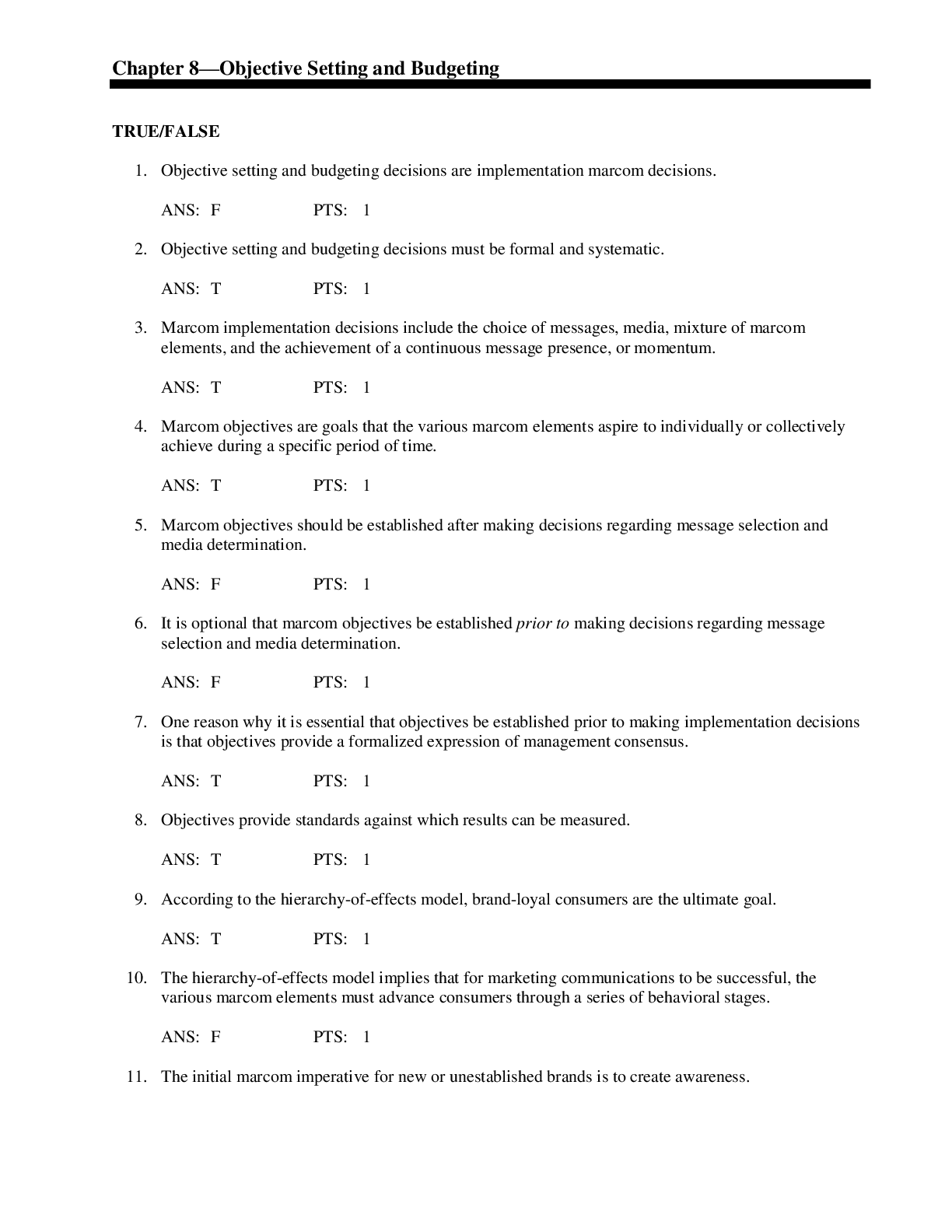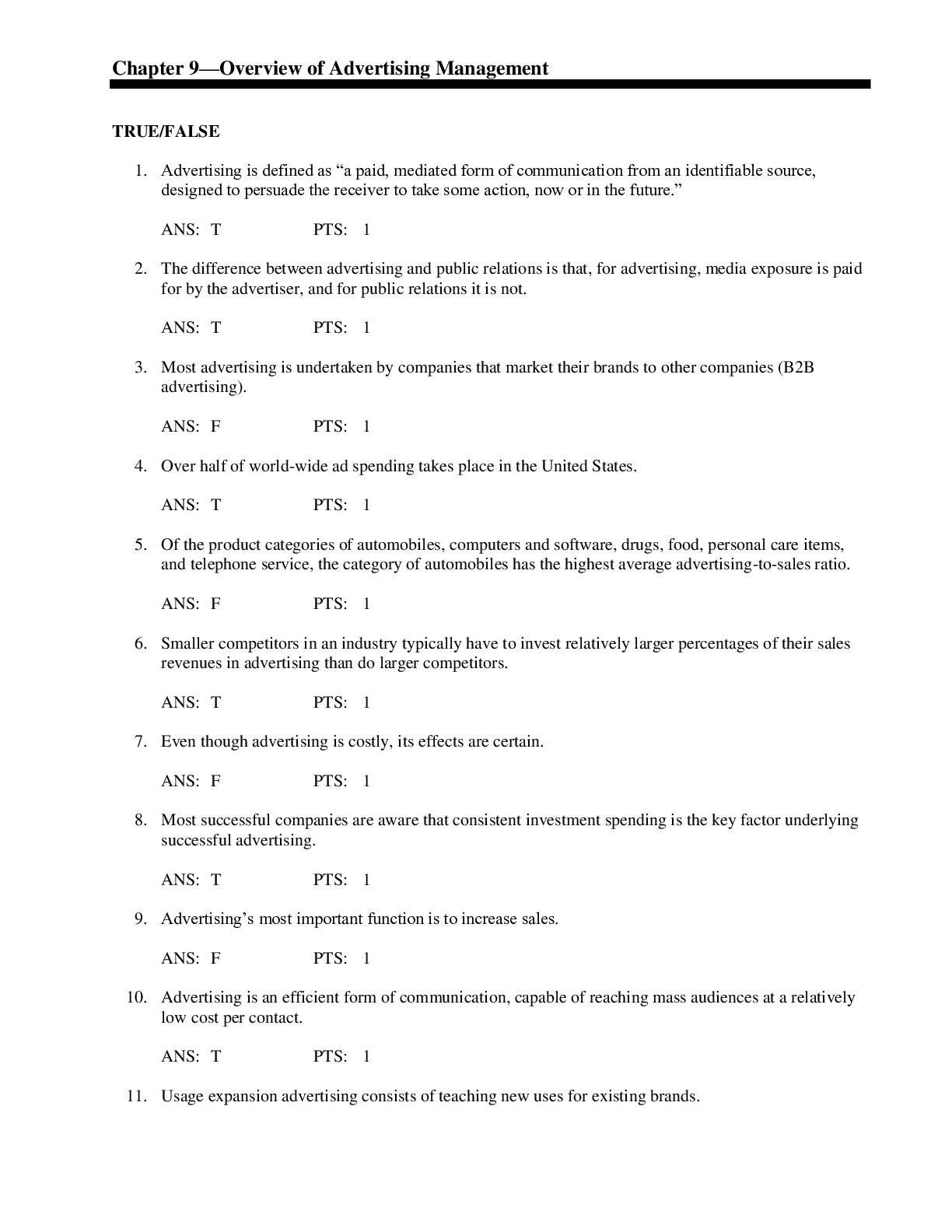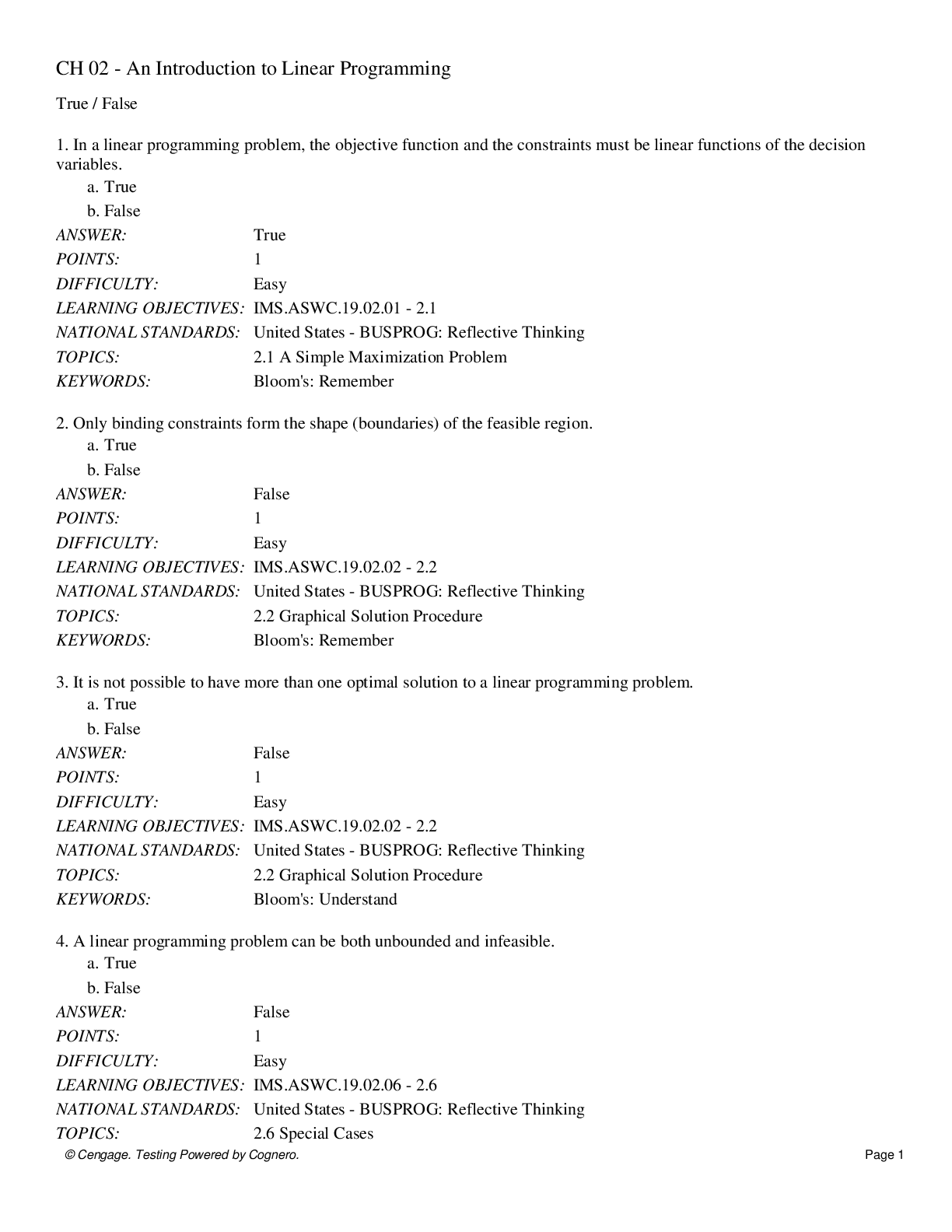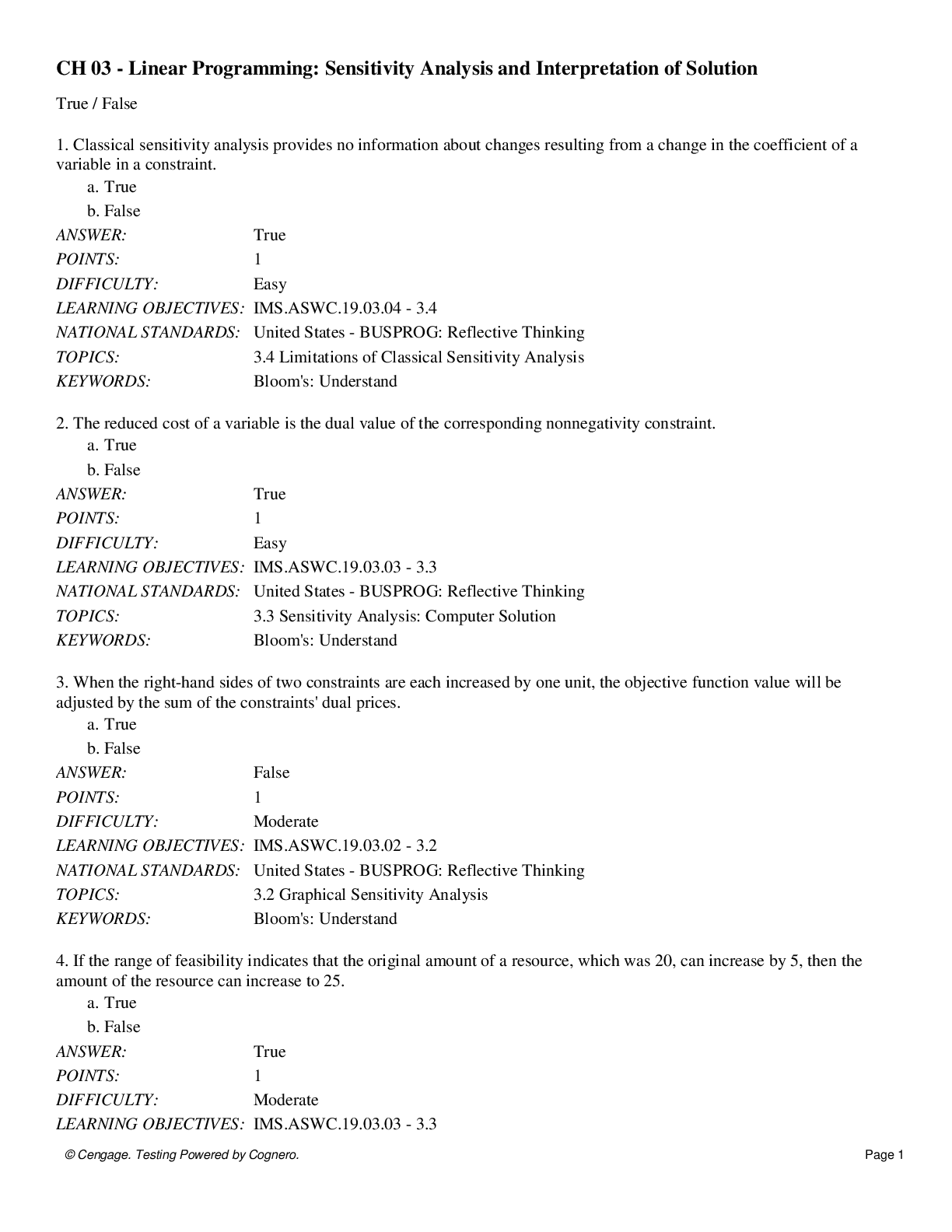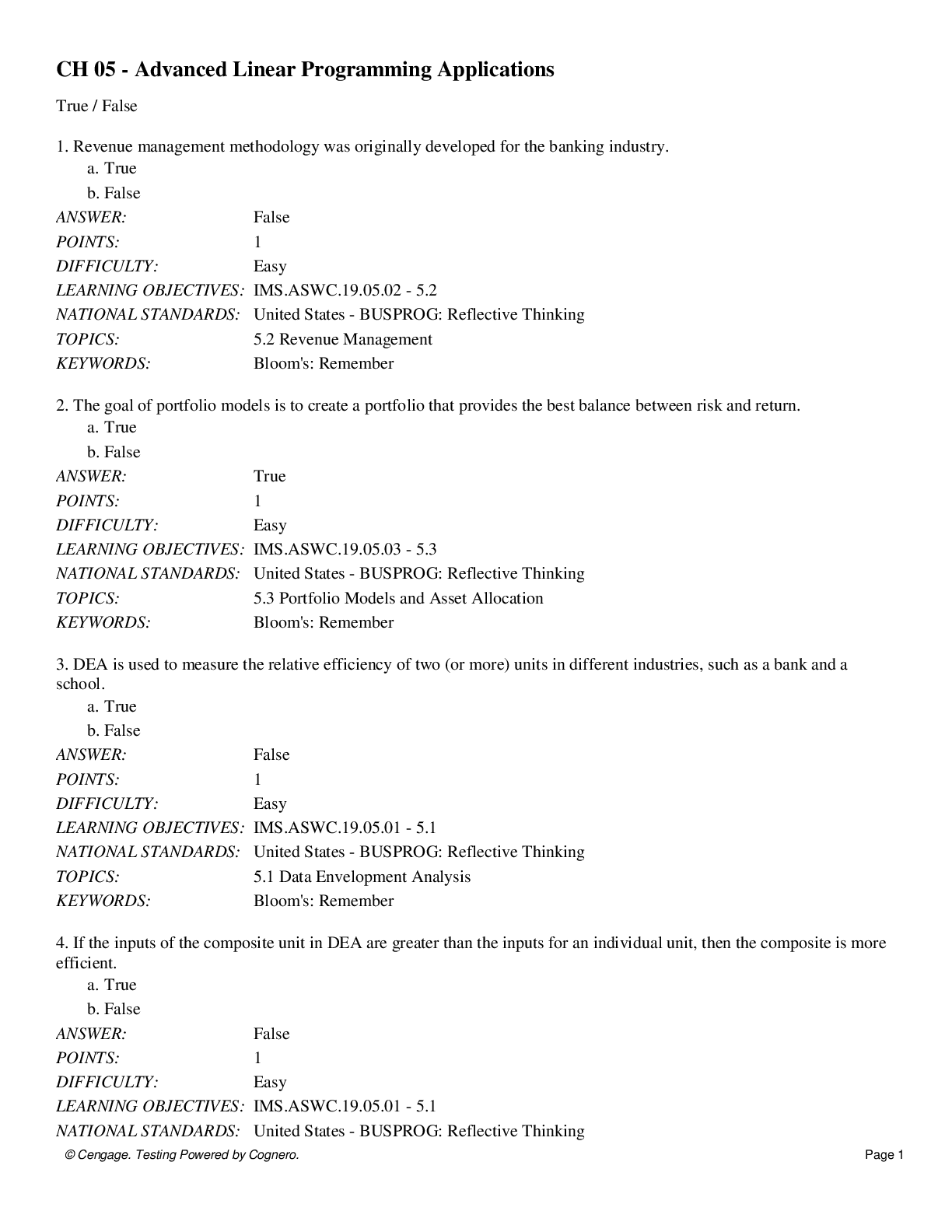*NURSING > QUESTIONS & ANSWERS > Community Health Nursing HESI Prep Questions and Answers 100% Pass (All)
Community Health Nursing HESI Prep Questions and Answers 100% Pass
Document Content and Description Below
Community Health Nursing HESI Prep Questions and Answers 100% Pass Humanistic Nursing Theory ✔✔studies the existence of reality of nursing Transcultural Nursing ✔✔comparison of differing cu... ltures to understand their similarities and their differences across human groups Culture ✔✔set of values, beliefs and traditions that are held by a specific group of people and that are handed down, generation to generation Leininger ✔✔1. cultural preservation or maintenance 2. cultural care accommodations or negotiation 3. cultural care re-patterning or restructuring Nightingale's 10 Canons ✔✔1. ventilation and warming 2. light and noise 3. cleanliness of the pt area 4.health of houses 5. bed and bedding 6. personal cleanliness 7. variety 8. offering hope and advice 9. food 10. observation Primary prevention ✔✔patient assessment and intervention to identify and reduce possible risk factors Secondary prevention ✔✔detection of symptoms that are a reaction to stressors, appropriately prioritizing interventions, and treatments that reduce the toxic effects of stressors Health ✔✔seen as a dynamic, positive state and not just absence of disease 5 A's of Health Care Access ✔✔availability, accessibility, affordability, acceptability, and accommodation Market justice ✔✔people are only entitled to what they can earn; the focus is on individual responsibility "minimal collective action and freedom from collective obligations except with respect to others fundamental rights Vulnerable populations ✔✔low income, less education, homelessness, military veterans, immigrants, prisoners, migrant and seasonal farm workers and their families, chronic illness, mental illness social determinants ✔✔are the circumstances in which people are born; grow up, live, work, and age as well as the systems put in place to deal with illness Health disparities ✔✔difference in health outcomes between populations, social, demographic and geographic Health inequities ✔✔modifiable associate with social inequalities and are considered unfair Leininger- Transcultural Nursing ✔✔requires an awareness of self, sensitivity to others, respectful dialogue Ethnocentric ✔✔tendency to believe others think the same was as "they do," have the same world view, culture Altruism ✔✔putting others interests before one's own, being present is an example Autonomy ✔✔PHN independent and responsible for actions - respects community and individual right to self-determination; maintain privacy, honesty, and fidelity Beneficence ✔✔seek to do good, not harm Common Good Perspective ✔✔good for the whole Ethics ✔✔standards of behavior that tell us how we ought to act in various situations we encounter in life Fairness Perspective ✔✔focuses on how fairly or unfairly actions affect a group - how benefits and burdens are distributed; requires consistency in the way people are treated Non-maleficence ✔✔first do no harm - primum non nocere Advance directive ✔✔legal document in which an individual conveys their decisions about endof-life care Health literacy ✔✔includes the ability to understand instructions on prescription drug bottles, appointment slips, medical education brochures, doctor's directions and consent forms and the ability to negotiate complex health care systems Pre-crisis ✔✔planning and test messages Initial ✔✔audience wants information NOW Maintenance ✔✔on-going assessment of the situation Resolution ✔✔community will not be ready to conduct risk reduction immediately after emergency Evaluation ✔✔Crisis and emergency risk communication response 4 P's of Social Marketing ✔✔product, price, place, promotion NICs ✔✔Nursing interventions classification NOCs ✔✔nursing outcomes classification Nursing minimum data set (NMDS) ✔✔standardizes the collection of nursing data; can provide accurate description of nursing dx, care and resources used to help define cost and quality of nursing care Tele-Health ✔✔electronic technologies to support clinical health care, patient and practitioner education, public health and health administration by long distance "Right-to-Know" Laws ✔✔give people and communities the right to know about possible chemical exposures where they live and work Infancy ✔✔trust vs. mistrust Early childhood (18 mo-3 yrs) ✔✔autonomy vs. shame play age (3-5 yrs) ✔✔initiative vs. guilt Adolescence (12-16yrs) ✔✔Identity vs. inferiority diffusion Middle adult (35-55/65 yrs) ✔✔generativity vs. self-absorption/stagnation late adulthood (55/65- death) ✔✔integrity vs. despair/wisdom Young adult (18-35 yrs) ✔✔intimacy vs. solidarity/isolation Sensory-motor stage ✔✔birth to two Pre-operational stage ✔✔about two to seven concrete operational stage ✔✔ages seven to eleven Formal operational stage ✔✔eleven years and older Epidemiology ✔✔distribution and determinants of health related states/events in populations and the use of this study to control health problems Prevalence ✔✔measures the proportion of the population affected by a specific condition in a specific time period Incidence ✔✔measures the risk of developing a new condition (disease, injury, symptom, or death), over a specific period of time, such as a year Mortality rate ✔✔also called death rate=an estimation of the proportion of a population that dies during a specified time period Epidemic ✔✔rates exceed normal or expected frequency in a given population/community/region Pandemic ✔✔worldwide epidemic (influenza and plague) Chain of causation ✔✔chain of events where every event caused by the previous event; the sequence of stops that have been identified as linked to the disease Web of causation ✔✔describes events that have multiple causative factors Passive Immunity ✔✔newborns via maternal antibodies Active immunity ✔✔acquired after exposure to a disease or via immunizations Cross-immunity ✔✔immunity to one pathogen confers immunity to another such as cowpox providing immunity to smallpox Herd-immunity ✔✔present in a population, the higher the immunity decreases risk of disease (use of immunizations); increasing immunizations reduces risk of exposure to disease of those not immunized Primary prevention ✔✔used before the person gets the disease or condition to reduce the incidence and prevalence of the disease; includes health promotion (education) and protection (immunization) Secondary prevention ✔✔applied after the disease has occurred but before signs are evident; focuses on early dx (screening) and prompt tx to limit disability Tertiary prevention ✔✔applied when person already has the disease, focuses on preventing damage from the condition, slowing the process of the disease, preventing complications, and returning the person afflicted to their optimal level of health (rehabilitation) Case Series and Case Reports ✔✔collection of reports; no control group, easy to understand and can be written quickly Case Control Studies ✔✔compare those with the disease to those without. estimates odds of getting the disease or condition, less reliable than randomized control trials, works well for rare conditions Cohort Studies ✔✔may be prospective or retrospective, used to establish causation or evaluate the impact of treatment when randomized control trials are not possible over time-- longitudinal; not good for rare conditions, requires large study group Randomized Controlled studies ✔✔requires a treatment group and a control group, pts are randomly assigned to all groups, considered "gold standard" of medical research to determine cause and effect double blind method ✔✔neither patient nor researcher knows if the subject is in the control or treatment group meta-analysis ✔✔combines data from numerous studies and arrives at pooled estimates of treatment effectiveness and statistical significance Descriptive studies ✔✔are observational studies that seek to describe phenomena Qualitative studies ✔✔describe phenomena of interest; include participant observation, in-depth interviews and focus groups Quantitative studies ✔✔seeks to confirm hypotheses about phenomena; uses more rigid style eliciting and categorizing responses sulfur dioxide ✔✔product of industry produces acid rain and contributes to respiratory illness nitrous oxide ✔✔combustion product contributes to illness of lungs, immune system and asthma carbon monoxide ✔✔car exhaust reduces oxygen delivery at high concentrations radon ✔✔naturally occurring radioactive gas that cannot be detected by our senses, but is the leading cause of lung cancer in non-smokers; it is the second cause of lung-cancer behind smoking consultation ✔✔involves seeking advice or an opinion of an expert; the consultant does not solve the problems, but assists and guides the group seeking consultation to solve their own problems collaboration ✔✔taking an active role in implementing the plan, this requires understanding of each party's perspectives, on-going communication and feedback coalition-building ✔✔alliance or group of stakeholders with a common interest/goal Advocacy ✔✔purpose is policy change; critical role for the public health nurse Cognitive ✔✔thinking (comprehension, analysis, synthesis, application, evaluation); evaluate the level of the learner affective ✔✔feeling (receptive, active participation, valuation, internalization), includes changes in attitude and values psychomotor ✔✔acting - demonstrates performance skills 6 stages of disaster life cycle ✔✔prepare, respond, mitigate, reduce the risk, and prevent natural disasters ✔✔due to weather or other natural occurrences man-made disasters ✔✔intentional power outages, chemical spills, acts of bio terrorism bacterial agents ✔✔anthrax, plague viral agents ✔✔smallpox Biological toxins-category A ✔✔considered high priority and pose national security threat-high morbidity and mortality smallpox, anthrax, plague, Ebola, Lassa fever, Q fever, botulism, tularemia, hemorrhagic fever Biological toxins-category B ✔✔moderate to low morbidity and mortality, difficult to detect Bucellosis, clostridia toxin, staph enterotoxin, salmonella, shigella, e.coli, cholera Biological toxins-category C ✔✔emerging pathogens such as yellow fever, drug resistant TB Family disaster plan ✔✔encourage families to prepare a family emergency/disaster kit, they might be deployed to local disaster sites Health outcomes ✔✔health promotion interventions there must be outcomes to measure analysis of proper structure and constructive process, operationalizing, outcomes (improved health = weight loss, lower blood sugars) Health status & quality of life indicators ✔✔individual perception based on health, cultural background, education, moral and ethical values, difficult to asses because it is very subjective Disparities ✔✔exist due to poverty, lower educational levels, unequal access to healthcare, language barriers, environmental conditions, racism Health Belief Model (HBM) ✔✔predicts health related behavior and compliance to prevent diseases; health promotion empowers populations so they can have control over personal health and access resources; perception, attract positive value (health) and repel negative value (illness) Transtheoretical Model (TTM) ✔✔five stages of progression (1) pre-contemplation- no thought of change (2) contemplation-owning the problem/evaluate options (3) preparation- plan of action (4) action-changes are attempted (5) maintenance-behavior sustained usually 6 mos or longer Health Promotion Model (Pender) ✔✔actions to improve health using the following driversindividual characteristics and experiences, behaviors, behavioral outcomes, health promotion, activities involve removing internal and external barriers and promoting public policy to remove barriers type of model Motivation ✔✔moved from contemplation to action Self-efficacy ✔✔belief about capabilities to produce effects Self-management ✔✔manage independently choices and consequences of life Compliance ✔✔degree to which a plan is followed (passive) Adherence ✔✔agreement to follow a plan of action (active) pedagogy ✔✔literally means the "art and science of teaching children" andrgogy ✔✔intentional and professionally guided activity the aims at a change in adults Nurse-managed centers ✔✔nurse-managed centers provide a safety net for the poor and undeserved in rural and urban areas; run by advanced practice nurses, and may be associated with universities or may be independent parish nursing ✔✔licensed, registered nurses practicing holistic care in faith communities correctional health nursing ✔✔nurses working with populations in jails, prisons, detention centers, holding facilities occupational health nursing ✔✔nurses working with populations within their work environment; provide workplace clinics, conduct safety education and improving working conditions to prevent injury; balance the company's need for productivity with knowledge of occupational health and workforce/place safety OSHA ✔✔sets health and safety work standards, employers are legally required to protect workers from hazards; employees have right to know what hazards they are exposed to HIPPA ✔✔protects the privacy of identifiable, private health information EPA ✔✔reduce environmental risk and protect the public, maintain safe air and water, establish pollution regulations, solid waste and toxic substance disposal, regulate pesticides, oversee radiation hazards, and noise abatement HHS (US Dept. of Health and Human Services) ✔✔principle government agency that protects the health of our country; under its umbrella are: CMS, CDC, NIH, FDA, SAMHSA CMS ✔✔Center for Medicare and Medicaid Services CDC ✔✔monitors and tracts diseases, research injury, infectious disease, environmental health, genomics, global health, chronic disease prevention, birth defects and developmental disorders; publishes the morbidity and mortality weekly report NIH ✔✔mission is to seek fundamental scientific truth about the natures and behavior of the living systems and the application of science to improve health, lengthen life and reduce the heavy load of illness and disability SAMHSA ✔✔Substance Abuse and Mental Health Administration; coordinates and funds sustainable substance abuse and mental health programs in communities or community health agencies stakeholders ✔✔those who stand to gain or lose from the success or failure of an initiative documentation standards ✔✔an agency's standards for how care is recorded/documented on an individual or program level; provides a legal record, and should be performed in a timely manner to ensure accuracy risk management protocol ✔✔identification of areas where mistakes of omission or commission can be made performance standards ✔✔defined standards/expectations for how business is to be conducted and how performance will be measured mentoring ✔✔expert who establishes a long-term relationship with a mentee to help them meet professional goals or learn the role preceptor ✔✔guidance and role modeling are ways to nurture colleagues or students professional credibility ✔✔clearly demonstrates expertise in an area expert ✔✔perform as an expert maintain standards of behavior and accountability [Show More]
Last updated: 1 year ago
Preview 1 out of 20 pages
Instant download
.png)
Buy this document to get the full access instantly
Instant Download Access after purchase
Add to cartInstant download
Also available in bundle (1)
.png)
HESI Community Health Bundled Exams Questions and Answers with Verified Solutions
HESI Community Health Bundled Exams Questions and Answers with Verified Solutions
By Nutmegs 1 year ago
$22
15
Reviews( 0 )
Document information
Connected school, study & course
About the document
Uploaded On
Feb 04, 2023
Number of pages
20
Written in
Additional information
This document has been written for:
Uploaded
Feb 04, 2023
Downloads
0
Views
86

.png)
.png)
.png)
.png)
.png)
.png)
.png)
.png)
.png)
.png)
.png)





